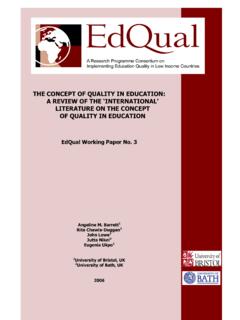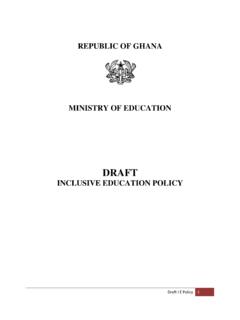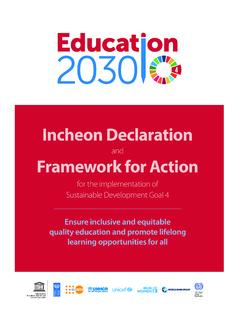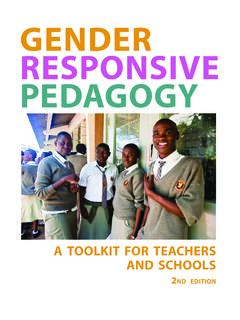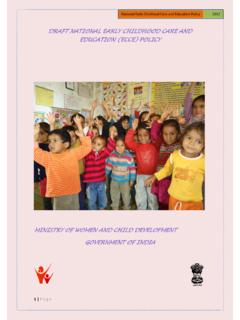Transcription of Overview of Gender Equality and Social Inclusion in Nepal
1 Overview of Gender Equalityand Social Inclusion in NepalOverview of Gender Equality and Social Inclusion in Nepal 2010 Asian Development BankAll rights reserved. Published in the 978-92-9092-198-1 Publication Stock No. RPS102685 Cataloging-In-Publication DataOverview of Gender Equality and Social Inclusion in City, Philippines: Asian Development Bank, Gender Equality . 2. Social Inclusion . 3. Nepal . I. Asian Development views expressed in this publication are those of the authors and do not necessarily reflect the views and policies of the Asian Development Bank (ADB) or its Board of Governors or the governments they does not guarantee the accuracy of the data included in this publication and accepts no responsibility for any consequence of their making any designation of or reference to a particular territory or geographic area, or by using the term country in this document, ADB does not intend to make any judgments as to the legal or other status of any territory or encourages printing or copying information exclusively for personal and noncommercial use with proper acknowledgment of ADB.
2 Users are restricted from reselling, redistributing, or creating derivative works for commercial purposes without the express, written consent of :In this publication, $ refers to US Development Bank6 ADB Avenue, Mandaluyong City1550 Metro Manila, PhilippinesTel +63 2 632 4444 Fax +63 2 636 orders, please contact:Department of External RelationsFax +63 2 636 ivBackground vContext of Gender and Social Exclusion in Nepal 1 Historical Context of Social Exclusion 1 Policy and Legal Framework 4 Development Planning 5 Institutional Framework 6 Role of Development Partners in Gender Equality and Social Inclusion 7 Gender and Social Exclusion in Nepal and Its Development Outcomes 9 Citizenship 10 Property Rights 10 Family Law 11 The Police 11 Employment and Labor Migration 11 Trafficking 13 Conflict, Reconciliation, and Peace 15 Gender -Based Violence 15 Social Security and Protection 16 Participation in Governance 17 Health 18 education 21 Agriculture and Natural Resource Management 25 Water Supply and Sanitation 28 Rural Transport Infrastructure 33 Energy 34 Conclusion 38 References 39 Annex 1.
3 Gender Equality and Social Inclusion Road Map 42 Annex 2: Gender Equality and Social Inclusion Results Framework 50ivAbbreviationsADB Asian Development BankAEPC Alternative Energy Promotion CentreCPS country partnership strategyDDC district development committeeEFA education for AllGESI Gender Equality and Social inclusionHDI Human Development IndexICPD International Conference on Population and DevelopmentILO International Labour OrganizationLGCDP Local Governance and Community Development ProgramMDG Millennium Development GoalMLD Ministry of Local DevelopmentMWCSW Ministry of Women, Children and Social WelfareNGO nongovernment organizationNORAD Norwegian Agency for Development CooperationREDP Rural Energy Development ProgrammeRE TA Regional Technical AssistanceSMC school management committeeSNV Netherlands Development OrganisationUNSCR United Nations Security Council ResolutionVDC village development committeeWCSC Women and Children Service CentreUN United NationsUNDP United Nations Development ProgrammeUNFPA United Nations Population FundUNICEF United Nations Children s FundUNIFEM United Nations Development Fund for WomenvBackgroundIn April 2006, Nepal s decade-long conflict came to an end and swept in vast political changes with the promise of more inclusive democracy and greater attention to disparities based on Gender , caste, ethnicity, and religion.
4 The successful conclusion of the Constituent Assembly elections and the declaration of Nepal as a federal republic on 28 May 2008 fostered hope for greater progress. However, the peace process has been complex and challenging and the Constituent Assembly faces the daunting task of drafting a new Constitution that will address the deep-rooted and systemic discrimination and exclusion that are seen to be the main cause of the restoration of peace provided opportunities to further the development and poverty reduction agenda. Nepal has aligned its development strategy and priorities with the Millennium Development Goals (MDGs). It is on track to achieve its MDG target for poverty reduction but faces difficulties in reaching the targets for universal primary education , environmental sustainability, and child nourishment. A critical challenge for the peace-building process will be the establish-ment of mechanisms to ensure that excluded groups have equitable access to the benefits and opportunities of objective of this report is to provide an Overview and update of Gender Equality and Social Inclusion issues in Nepal and their impact on development outcomes.
5 Recent policy and legal frameworks to address Gender Equality and Social Inclusion will also be of Gender and Social Exclusion in Nepaland the Madhesis, the southern plain dwellers of the Tarai belt (the plains region of Nepal ), who were not even included in the Muluki Ain. The patriarchal system also assigns women a subor-dinate status and position in society, which was reflected in state-based new Constitution formulated after the establishment of multiparty democracy in 1990 described Nepal as a multi-ethnic, multi-lingual, and democratic state and declared all citizens equal. Democracy provided space for diverse groups and civil society organizations, especially those based on ethnicity and caste, to assert their identities and rights. However, the political parties, who were dominated by the Brahmans, Chhetris, and Newars, did not address their disproportion-ate representation in governance structures, but rather maintained the status quo.
6 The inability of government to effectively ensure more equitable political representation and inclusive develop-ment for the marginalized groups allowed the Maoist insurgents to exploit Social disparities to their advantage in their People s War. The Maoist ideology of Gender and class Equality was able to attract a large number of women and Janajatis to Historical Context of Social ExclusionSocial exclusion is entrenched in the political, economic, and Social fabric of Nepal and has been a defining feature of its historical develop-ment. In the context of Nepal , the Hindu caste system traditionally categorized people into four groups (Figure 1): Brahmin (scholars and priests) at the top, Chhetri (warriors) just below, then the Vaishya (merchants and traders), and lastly, Sudra (peasants/laborers). Below everyone were the occupational groups considered impure the untouchables, who now refer to themselves as Dalits.
7 The Muluki Ain (Civil Code) of 1854 legally formalized the highly rigid and hierarchical caste system and brought the Adivasi Janajatis (non-Hindu indigenous nationalities) into the system with middle-rank status. Despite the abolition of caste-based discrimination in 1963, the Social hierarchies and divisions remained, vesting more power and privilege in the Brahman, Chhetri, and Newar1 caste groups in the hills region. The consolidation of economic and political power by these groups led to further marginalization of the non-Hindus ( , Adivasi Janajatis and Muslims) 1 Newars are an ethnic group with a common language and caste system and whose ancestral home is the Kathmandu of Gender Equality and Social Inclusion in Nepaltheir movement despite the fact that their leader-ship comprised primarily of elite armed conflict established the space for a more inclusive democracy and provided an opportunity to address issues of Social exclusion.
8 The government has amended several discrimina-tory laws and provisions. It has shown its commit-ment to Gender Equality and Social Inclusion by 2 Aasland, Aadne and Marit Haug. 2008. Social Exclusion in Nepal Stronger or Weaker? pp. 13 14. a number of international conventions. Moreover, it has recognized that the barriers to Inclusion are due to not only Gender , caste, and ethnicity but also to language, religion, disability, geography, and regional identity. However, unless sociocultural norms and attitudes toward Gender Equality and Inclusion change, there will be lim-ited real change in discriminatory 1 The Caste Hierarchy in Nepal (1854 Muluki Ain) High Caste High Caste NewarJanajati Low Caste Dalit Impure Pure BrahmanChhetriTagadhari Twice Born UnenslavableEnslavableIndigenous/Ethnic GroupsMatwali Liquor-Drinking Pani Na Chalne Water-Unacceptable Muslims & ForeignersAcchut Untouchable Source: World Bank.
9 2009. Unequal Citizens: Gender Caste and Ethnic Exclusion in Nepal . Washington, of Gender and Social Exclusion in NepalExplanation of Key TermsSocial Exclusion: Describes the experience of groups that are systematically and historically disadvantaged because of discrimination based on Gender , caste, ethnicity, or religion. Exclusion occurs in public (formal) insti-tutions such as the legal or education system, as well as Social (informal) institutions such as communities and Inclusion : The removal of institutional barriers and the enhancement of incentives to increase access by diverse individuals and groups to development opportunities. This requires changes in policies, rules, and Social practices and shifts in people s perspectives and behavior toward excluded : Refers to the socially constructed roles and identities of men and women as well as the relationships between them. These roles change over time and vary by culture. In Nepal , women face unequal power relations and Gender -based barriers due to a patriarchal : Refers to the Hindu hierarchal system, which originated by categorizing people into caste groups accord-ing to the division of labor, roles, and functions.
10 In Nepal , the upper castes refer to the Brahmans and Chhetris and the lower castes refer to the Dalits who suffer from caste- and untouchability-based practice and religious, Social , economic, political, and cultural discrimination. The Dalits comprise 13% of Nepal s population and can be classified into 6 subcaste groups from the hills (Hill Dalits) and 10 subcaste groups from the Terai (Madhesi Dalits).Adivasi Janajatis: People or communities having their own mother tongue and traditional customs, distinct cultural identity, Social structure, and written or oral history. Interchangeably referred to as Janajatis, ethnic groups, and indigenous nationalities. The government identified 59 groups as indigenous nationalities and these are categorized into 5 groups based on their economic and sociocultural These include endan-gered, highly marginalized, marginalized, disadvantaged, and advanced groups.










